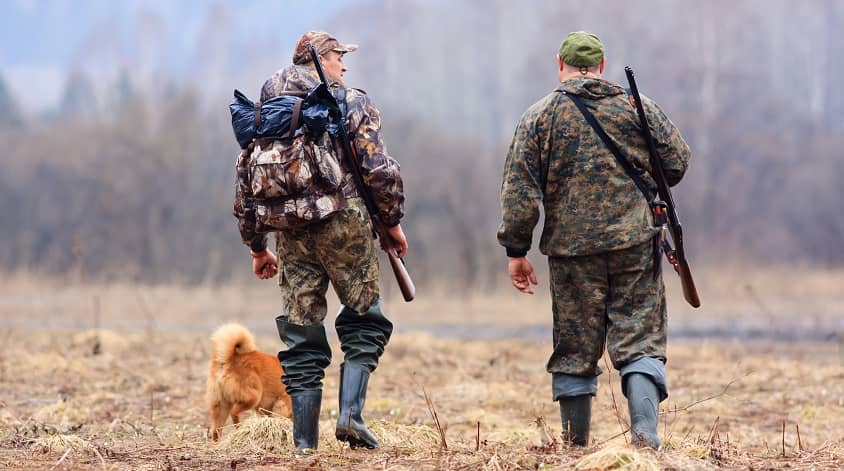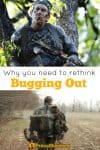I love talking with people about disaster preparedness and survival. The one issue that almost always comes up is bugging out.
Somewhere along the line, people got the idea that they would grab their Bug Out Bag and flee into the wilderness or some secluded location at the first sign of danger.
Yes, I firmly believe everyone should know how to survive in the wilderness and live off the land with minimal supplies.
Everyone should also have a Bug Out Bag packed in case disaster strikes (get a Complete Bug Out Bag Checklist here)
That does NOT mean that everyone should bug out!
In most cases, bugging in (aka staying at home) makes much more sense than fleeing.
Preppers Have Romanticized the Idea of Bugging Out
The prepper community has done a good job of romanticizing the idea of bugging out. They make it sound like a Boy Scout trip into the woods where you will get to chill out, fish all day and laugh your ass off at everyone else for not being as smart as you.
But…
In a disaster situation, bugging out won’t be as fun as camping with your buddies.
It will be harder than any survival course you’ve taken because you won’t have a warm home to return to after the course finishes.
Bugging out will get lonely, and you will be terrified at times.
Let’s be clear: If you have to bug out, you will be a refugee. Being a refugee is not any fun. It makes sense that most people fleeing disasters go to places where they have social bonds – but often, those places aren’t safe either.

Bugging In Is Probably the Smarter Option
Pretty much every survivalist expert agrees that hunkering down is usually the smarter option in a disaster situation.
After all, isn’t this what we’ve been preparing for by stockpiling food, water, and other supplies?
Bugging out makes much more sense in some cases. For example, if I knew a major hurricane was coming and had adequate warning, there is no way I’d stay home, regardless of how many supplies I had. I’d take my family to a safe place to ride out the hurricane!
But we don’t always have a warning that a disaster is about to strike. We find ourselves in the midst of the disaster. At this point, you will probably want to hunker down.
Let’s break down when you should bug out or hunker down
Bug Out If…
- You’ve had adequate warning that the disaster is coming and can flee before the disaster strikes.
- You have a bug out location.
- You are sure your bug out location is safer than your current location.
- You have emergency supplies at your location.
- You have a means of getting to your bug out location.
- You are in imminent danger at your current location.
- The risk of staying at your current location is greater than traveling to your bug out location.
Hunker Down If…
- You are not in immediate danger at your current location.
- You have emergency supplies at your current location.
- The journey to your bug out location could put you in worse danger than staying home.
- You can rely on your community during the disaster.
- You have old, young, disabled, or people with health issues in your group.
If You Do Bug Out, This Is What It Will Really Be Like…
In the most common disasters (hurricanes, earthquakes, flooding), bugging out won’t mean going to a remote cabin in the woods or making a survival shelter in the wilderness.
Bugging out will probably mean you stay with friends or family living outside the danger zone but are still close enough to get to quickly.
Ironically, many preppers have a secure bug-out location in the wilderness but haven’t even TALKED TO THEIR RELATIVES about whether they could come to stay during a disaster.
Do you know where your relatives live?
Would you be able to get there without your GPS?
How would you contact your relatives? Do you know their phone number in your emergency contact list???
The problem is that no one likes planning for small-scale disasters. It isn’t as thrilling or exciting to talk about what would happen if your home caught fire or some flooding occurred.
Instead, the discussion revolves around SHTF end-of-the-world scenarios where we have to flee to the wilderness and survive on our wits. That’s the romanticizing I mentioned before.
You Need Multiple Bug Out Plans
If you have any Bug Out plan, you are doing better than the average person. But this isn’t enough. You need multiple Bug Out plans (yes, more than one!) and know when to utilize them.
Bug Out Plan #1: Local Disasters
These are the most common types of disasters we encounter and are usually weather-related. The good news is that we are typically warned that the disaster will strike. Of course, this isn’t always the case. None of the 9/11 victims got any warning!
For these types of local disasters, you need to plan for the conditions under which you would flee and where you would go. It will probably be to a friend or family’s home to ride out the disaster. You won’t need any wilderness survival skills for this type of bugging out—just a plan to ACT QUICKLY. Ensure your family communication plan is in order so you can group quickly and get out of dodge!
Bug Out Plan #2: Major Disasters
These are the types of disasters we usually talk about with bugging out. The EMP strikes, biochemical terrorist attacks, grid outages…
In these major disaster cases, you are probably better off staying home. Since the disaster affects the entire region or country, leaving can put you at risk and there is no guarantee that your Bug Out location will be safe.
However, if you have carefully planned your Bug Out location and route and have your Go Bag ready, the risk of staying might outweigh the risks of fleeing.
Bug Out Plan #3: Slow Buildup Disasters
Yes, an EMP strike or solar flare could make the entire country (and world!) devolve into chaos in just a matter of seconds. But most large-scale disasters don’t occur overnight.
Take the survival lessons learned from the Syrian war. War, terrorism, famine, and drought didn’t happen all at once. The situation started slowly and then began to devolve. Like a pile of shit rolling down a hill, it picks up speed as it goes.
The most important thing we can learn from the Syria example is that…
You need to Get Out of Dodge BEFORE things get even worse.
Don’t let wishful thinking and emotions get the better of you. Things won’t get better. Know when it is time to bug out to your secure, remote location. If you don’t do it right away, bugging out might not be an option late.
Remember that disasters don’t always occur while you are at home. So, you’ve also got to get home to hunker down! Be sure to have a Get Home Bag packed.
Hunters” (CC BY-NC-ND 2.0) by Tudy



don;t do it .stay home hunker down build on what you already have i have live in the bush in good times and its not fun. most people are to civilized now they have lost the edge. stay home.
Finally. An article about bugging out. That makes some sense. That’s the last thing people need is a bunch of nut jobs running around the woods. Trespassing and shooting anything with a heartbeat. Thinking all hope is lost. And the world is going to end. Please, use your heads!
.